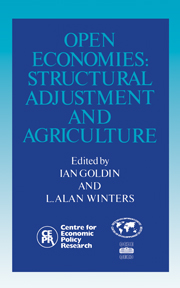Book contents
- Frontmatter
- Contents
- List of figures
- List of tables
- Preface
- Acknowledgements
- List of conference participants
- 1 Introduction: from macro to maize
- Part One Open economy analysis
- Part Two The small country assumption and trade reform
- Part Three Risk and adjustment
- 9 Markets, stabilisation and structural adjustment in Eastern European agriculture
- Discussion
- 10 Should marketing boards stabilise prices through forward purchases?
- Discussion
- Part Four Government's role
- Index
9 - Markets, stabilisation and structural adjustment in Eastern European agriculture
from Part Three - Risk and adjustment
Published online by Cambridge University Press: 04 August 2010
- Frontmatter
- Contents
- List of figures
- List of tables
- Preface
- Acknowledgements
- List of conference participants
- 1 Introduction: from macro to maize
- Part One Open economy analysis
- Part Two The small country assumption and trade reform
- Part Three Risk and adjustment
- 9 Markets, stabilisation and structural adjustment in Eastern European agriculture
- Discussion
- 10 Should marketing boards stabilise prices through forward purchases?
- Discussion
- Part Four Government's role
- Index
Summary
Introduction
In this paper we consider issues arising in the development of a market economy in Eastern Europe, with particular reference to agriculture. The central question addressed is: to what extent is it possible to achieve the transformation from a planned economy to a market economy while satisfying a desire for a stable economic environment?
It is frequently stated that there are currently large uncertainties facing Eastern Europe. For instance, the future of the USSR, the major trading partner of all of the countries in the region, is a significant, exogenous source of uncertainty. Moreover, there are crucial uncertainties relating to the adjustment within the countries of the region. How will the proposed privatisation plans proceed? Where will true comparative advantages lie?
In many cases, changes are likely to arise in the form of discrete shocks rather than smooth processes and changes are likely to be permanent, not temporary. For instance, a collapse in the USSR, if it does occur, may be sudden. Changes in exchange rates are likely to be discrete, permanent devaluations. Changes in the trade regime, opening these economies to increased Western imports, are also likely to be in the form of discrete and permanent shocks.
In the face of these uncertainties, there is an understandable tendency for enterprises and individuals to seek stability. This is particularly marked in agriculture. The plea for greater stability has often been in the form of a call for state interventions. Indeed, one way of satisfying the desire for stability is simply to stop the process of liberalising the economy.
- Type
- Chapter
- Information
- Open EconomiesStructural Adjustment and Agriculture, pp. 203 - 218Publisher: Cambridge University PressPrint publication year: 1992
- 2
- Cited by



